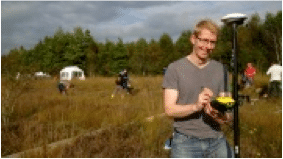Peat moss cultivation project underway
Klasmann-Deilmann has embarked on the world’s largest project cultivating peat moss. In close collaboration with the University of Hannover, a total of 10 hectares of land formerly used for peat extraction are to be prepared by the end of 2016. Over the past few weeks, more than three hectares have already been ‘inoculated’ with peat moss. The aim of this undertaking, funded by the federal state of Lower Saxony, is to develop a renewable resource for substrate manufacture. To this end, peat moss growth must be stimulated so that appreciable quantities are obtained.
Summing up progress, Managing Director Moritz Böcking says: “We have successfully completed the first stage of the project, namely collecting and distributing the peat moss.” What will be important in the winter months is that the growing sites show good development and the peat moss copes with the change of location. In the year ahead, these activities will be considerably expanded, with the remaining two-thirds of the designated area inoculated. Various irrigation and drainage techniques will be trialled in this connection with a view to minimising fluctuations in water level. “At the same time, we will be starting large-scale trials aimed at testing the moss’s suitability for use in substrates. Also on the agenda is the devising of a workable and cost-effective harvesting method,” adds Böcking.
The go-ahead for this research project was given in the summer of 2015, which is also when the University of Hannover and the Thünen Institute in Braunschweig began scientifically investigating any changes over time in biodiversity on the sites in question, and in greenhouse gas emissions. “We expect that the sequestration of greenhouse gases can be accelerated when the peat moss starts to grow on its new site,” comments Böcking. A continuous exchange of information is taking place with Canada’s Sphagnum Peat Moss Association, which is pursuing similar projects. The International Peatland Society (IPS) is also involved; the IPS is collating the findings of such undertakings and conducting scientific follow-up. “We are especially pleased about the close and constructive cooperation with the Emsland district authority, which has green-lighted this important research project.”
Moss from peat hummocks is specifically required for this project. This moss has been removed from already restored areas and then distributed over sites where standard re-wetting practice had already been implemented or was still due to be carried out. Full approval for this was obtained from the relevant authorities, thus making sure that these activities meet the highest environmental standards. “We are maximising transparency in our communication on this project, and are available for open dialogue with nature conservation organisations,” Böcking assures.
After extensive preparations, the first third of the two five-hectare growing sites 
On the re-wetted peatland site Provinzialmoor, a ‘Sphagnum bank’ is being created as a peat moss reservoir for restored sites in the future. Another former peat extraction site, Drenth, is serving as a kind of lab in which biomass growth and the resistance of the various cultivated peat mosses are being tested, as is their suitability as a substrate constituent.